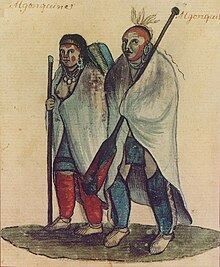
Algonquian couple, 18th-century watercolor.
Before Europeans came into contact, most Algonquian settlements lived by hunting and fishing, although quite a few supplemented their diet by cultivating corn, beans and squash.
The Algonquians of New England (who spoke Eastern Algonquian) practiced a seasonal economy. The basic social unit was the village: a few hundred people related by a clan kinship structure. Villages were temporary and mobile. The people moved to locations of greatest natural food supply, often breaking into smaller units or recombining as the circumstances required. This custom resulted in a certain degree of cross-tribal mobility, especially in troubled times.
In warm weather, they constructed light wigwams for portability. Wigwams are a type of hut which usually had buckskin doors. In the winter, they erected the more substantial long houses, in which more than one clan could reside. They cached food supplies in more permanent, semi-subterranean structures.
In the spring, when the fish were spawning, they left the winter camps to build villages at coastal locations and waterfalls. In March they caught smelt in nets and weirs, moving about in birch bark canoes. In April they netted alewife, sturgeon and salmon. In May they caught cod with hook and line in the ocean; and trout, smelt, striped bass and flounder in the estuaries and streams. Putting out to sea, the men hunted whales, porpoises, walruses and seals. The women and children gathered scallops, mussels, clams and crabs, all the basis of menus in New England today.
From April through October, natives hunted migratory birds and their eggs: Canada geese, Brant, mourning doves and others. In July and August they gathered strawberries, raspberries, blueberries and nuts. In September they split into small groups and moved up the streams to the forest. There the men hunted beaver, caribou, moose and white-tailed deer.
In December when the snows began, the people created larger winter camps in sheltered locations, where they built or reconstructed long houses. February and March were lean times. The tribes in southern New England and other northern latitudes had to rely on cached food. Northerners developed a practice of going hungry for several days at a time. Historians hypothesize that this practice kept the population down, according to Liebig's law. The northerners were food gatherers only.
The southern Algonquians of New England relied predominantly on slash-and-burn agriculture. They cleared fields by burning for one or two years of cultivation, after which the village moved to another location. This is the reason the English found the region relatively cleared and ready for planting. By using various kinds of native corn (maize), beans and squash, southern New England natives were able to improve their diet to such a degree that their population increased and they reached a density of 287 people per square hundred miles, as opposed to 41 in the north.
Even with mobile crop rotation, southern villages were necessarily less mobile than northern. The natives continued their seasonal occupation but tended to move into fixed villages near their lands. They adjusted to the change partially by developing a gender-oriented division of labor. The women cultivated crops, and the men fished and hunted.
Scholars estimate that by the year 1600, the indigenous population of New England had reached 70,000–100,000.At the time of the first European settlements in North America, Algonquian tribes occupied New Brunswick, and much of Canada east of the Rocky Mountains; what is now New England, New Jersey, southeastern New York, Delaware and down the Atlantic Coast through the Upper South; and around the Great Lakes in present-day Minnesota, Wisconsin, Michigan, Illinois, Indiana and Iowa. They were most concentrated in the New England region. The homeland of the Algonquian peoples is not known. At the time of the European arrival, the hegemonic Iroquois federation, based in present-day New York and Pennsylvania, was regularly at war with Algonquian neighbors. It forced other tribes out of Iroquois-occupied territories.
For about two centuries, Algonquians provided the main obstacles to the spread of Euro-American settlers, who concluded hundreds of peace treaties with them. Metacomet, Powhatan, Cornstalk, Tecumseh and Pontiac were leaders of Algonquian-speaking nations. www.wikipedia.com
EB
Kin 12: Yellow Crystal Human
I dedicate in order to influence
Universalizing wisdom
I seal the process of free will
With the crystal tone of cooperation
I am guided by the power of flowering.
As a force of evolution Cosmic History provides everything you did not perceive in the rear-view mirror, because you were going too fast.*
*Star Traveler's 13 Moon Almanac of Synchronicity, Galactic Research Institute, Law of Time Press, Ashland, Oregon, 2015-2016.
The Sacred Tzolk'in
Visshudha Chakra (Alpha Plasma)




No comments:
Post a Comment